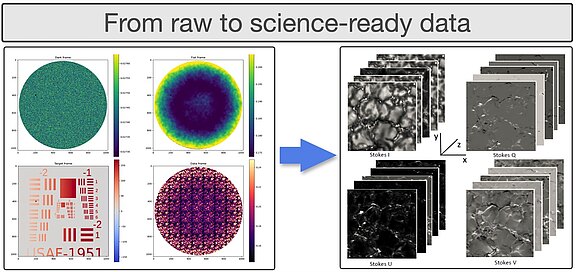On 15. December 2021, the calibration pipeline prototype for data from the Visible Tunable Filter (VTF) instrument was delivered to the DKIST Data Center according to the agreements between KIS and AURA within the framework of the VTF development. VTF, built by KIS, is one of the first-light instruments for the DKIST telescope on Maui. The prototype calibration pipeline is written in Python in a modular fashion. It makes use of significant external libraries (numpy, scipy, astropy, skimage, …) and calibrates FITS raw (or level 0) data compliant with the DKIST (meta-)data standards. The pipeline prototype has been developed jointly by Aperio Software Ltd. (UK, SDC partner) and members of the VTF Team (M. Schubert), SDC (N. Bello González) and Solar Physics Group (R. Schlichenmaier) within the framework of the SOLARNET H2020 project and in close collaboration with the DKIST Data Center team.
The pipeline calibrates data taking into account the instrumental effects, (camera) dark currents and data alignment. Furthermore, the pipeline is capable to run very fast reconstructions of the broadband channel data thanks to the GPU-integrated speckle code developed by Wöger et al. (NSO). The pipeline also runs speckle interferometry based on the method by Keller & von der Lühe (1992, A&A 261, 321) to reconstruct the narrowband channel data. The reduced and reconstructed data for the different (four) polarization states are finally demodulated to retrieve the Stokes profiles, i.e., science-ready data.
This prototype will now be implemented at the DKIST Data Center by their team. For testing purposes, KIS has made use of two VTF mock datasets: one based on MuRAM (Vögler et al. 2005, A&A 429, 335) simulations mimicking the expected performance of VTF and a second based on CRISP (Scharmer 2006, A&A 447, 1111; attached to the Swedish Solar Telescope) data whose basic characteristics (telecentric mounting and spectral resolution) are comparable to those of VTF.
Collaborations with Aperio Software Ltd. (UK) and with the DKIST Data Center Team will continue until the prototype is fully integrated and running on real VTF data.
For more information, please contact:
M. Schubert (KIS), schubert@~@leibniz-kis.de
Acknowledgments:
The simulated VTF-mock data (Schubert, PhD thesis) consist of MuRAM runs by M. Rempel (HAO) and spectral synthesis by J.M. Borrero (KIS).
The CRISP/SST data were provided by Jaime de la Cruz Rodríguez (Stockholm University).
Tests on the broadband reconstruction have been run by V. Gangadharan (SDC/KIS).
